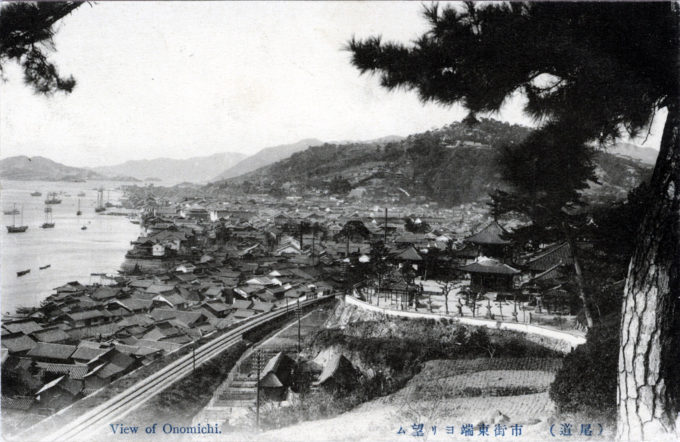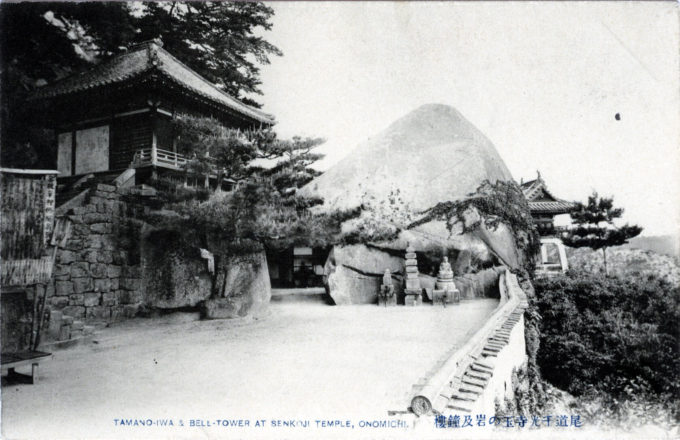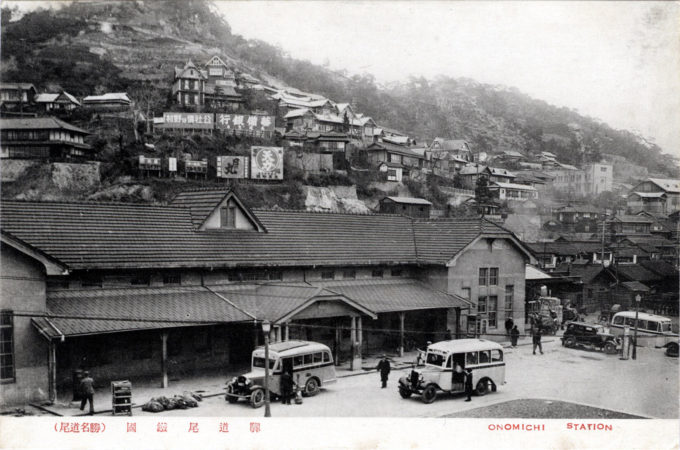
Aerial view of Onomichi, Inland Sea, c. 1920. The city’s port opened in 1168 and, for the next 500 years, served as a rice shipment center and a port for all trades with foreign countries. Its commercial significance somewhat wavered during the Tokugawa era of seclusion.
Trivia: Onomichi is featured in the classic Japanese film Tokyo Story (1953).
More trivia: Onomichi has gained more recent fame for its “Cat Street View project,” a Google-style map of the town filmed from a cat’s perspective.
“Onomichi, one of the best ports on the Island Sea, is also one of the most picturesque. Opposite the town, which stretches for a mile or more along the shore, is Muko Islet, and between them comes an arm of the sea which serves as a thoroughfare and an anchoring- ground for hundreds of queer craft engaged in the fishing or carrying trade of the Inland Sea.
“If the traveler should happen to pass through Onomichi on a day when the sun shines brilliantly and suggests the lower tropics, he will be reminded strongly of Constantinople and the Golden Horn.
“The thousands of tiled roofs glistening in the sun, the calm blue water flecked with big white-sailed junks, the scores and scores of lesser craft, the snowy gulls that wheel and scream and fish, and the deep, booming notes of the temple bells ringing their muezzin-like calls to the faithful, all combine to form an enrapturing picture.”
– Terry’s Japanese Empire, by T. Philip Terry, 1914
“Onomichi, the first port of call after Kobe, is a picturesque town in the province of Bingo. It lies on the northern coast of the Inland Sea at a point where that remarkable sheet of water is almost completely spanned by a bridge of islands. The place offers many evidences of prosperity but with the exception of fine views obtainable from the heights crowned by temples there are no features of interest.”
– Handbook of Information for Passengers & Shippers by the Steamers of the Nihon Yūsen Kaisha, 1904
“The San’yo Tetsudo’s [San’yo Express] segment to Onomichi, in the former Bingo province, was open November 3, 1891.”
– Early Japanese Railways 1853-1914: Engineering Triumps That Transformed Meiji-era Japan, by Dan Free, 2012

Elevated view of Onomichi, Inland Sea, c. 1920, with the railroad of the San’yo Line in the foreground.
“Onomichi remains relatively unknown abroad. This allows foreign travelers an opportunity to enjoy a perhaps more authentic ‘Japan’ experience without having to fight through massive crowds of camera-toting tourists.
“Because it escaped bombing during the war, a great deal of traditional housing remains intact. Whether wandering the winding mountain paths of Senkouji Yama just north of the station, or the narrow streets of Shingai, Onomichi’s feudal-era red-light area, one can get a real sense of Japanese life from ages past.”
“Onomichi Port began to prosper in the late 12th century, after its recognition as an ‘official port’, as a sending off port of annual tributes. Vessels called Kitamae-bune [northbound ships], which connected Hokkaido to Osaka, began making port calls in the Edo period.
“Due to the great prosperity, some people became very wealthy. These people were called Gousho [wealthy merchant], and they invested their wealth in the construction of temples, the maintenance of the city, and other projects. Those temples and much of the city’s atmosphere that is easily seen today is an outgrowth of those great fortunes and the desire of the Gousho to create abundant beauty.”
– Onomichi: A City of Hidden Gems, WideIslandView, Septembetr 2008



